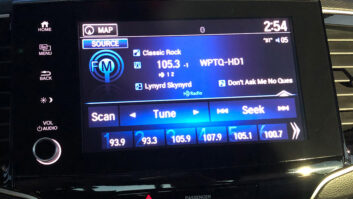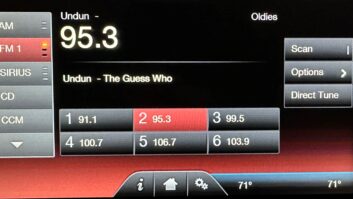
ELMIRA, N.Y. — When Backyard Broadcasting’s Elmira/Corning, N.Y., group was looking to upgrade a collection of consoles that included an LPB and a Continental Mark 8, the choices were practically endless for consoles that could perform the same duties.
Selection became more difficult when reliability, functionality and expandability were considered. We also needed a console system that would be flexible enough for each studio’s ever-changing role. As in most markets, optimizing studio space and time was a must. We needed each studio to be interchangeable between being live, voice-tracking and production, several times daily.
Our choices — the Logitek JetStream Mini console engine as a modern digital audio backbone, and Logitek ROC control surfaces — do this and more.
Configuration
The 2RU Mini has eight I/O card slots. Each slot accepts one of the 10 format I/O cards offered. Each of those individual cards can be configured with either eight mono (four stereo) sources or outputs and come equipped with either StudioHub-compatible RJ-45 connectors or a single DB-25 connector. They are hot-swappable, and changing the input type or switching inputs to outputs can be done quickly even with the unit online.
The mic input card, the JSM-Mic, provides four mono preamplified mic inputs with trim and phantom power, making the JetStream Mini a good choice for a standalone console as well as a networked option. The RJ-45 cards, teamed with the prewired Logilink block option, make for quick connections to a 66 block with factory-made Cat-5 cables.
Each JetStream Mini allows for 32 simultaneous stereo mix channels across one or two surfaces. The Mini comes equipped with an embedded PC and all of the Logitek software including vScreen, vRoute and vMix onboard. There is now no need for us to dedicate an external PC for programming and operations. The chassis itself has 12 GP inputs and 16 outputs across four DB-15 GPIO connectors. These can also be ordered prewired to a 66 block for quick integration with outside gear. The triggers can be used in tandem to make routing or mix-minus changes, even create default console layouts.
Software triggers functions in conjunction with the consoles’ soft keys, and GPIs allow making changes extremely easy for an operator. Software options also include built-in mic processing, profanity delay and direct network connections to automation systems. Networking the JetStreams makes sources and destinations available at each surface. Networking consists of connecting the JetStream through a managed IGMP switch. One compatible Netgear switch costs less than $100.
To drive the JetStream Minis, I chose the ROC series consoles, also from Logitek. We are using three ROC-12s, and a ROC-18 for our air studios plus a ROC-6 for production. The console itself is simply laid out, reducing the learning curve for both new and seasoned air staff.
I was able to assign and lock inputs, bussing and mix-minuses to be exactly the same as the previous consoles. This allowed the users to have a familiarity with the console and get a feel for it without having to hunt for buttons. It also allowed time to become more familiar with programming trigger functions.
After operators became comfortable with the basic operations, and in some cases using the Penny & Giles faders instead of rotary pots, I was able to add even more functionality. One standout feature of the ROC is the OLED display on every channel. Each fader is configured with a pre-fade VU meter and channel label. The operator can now tell if the channel has audio even before they hit the cue button. Even the on/off buttons can be assigned one of 256 colors, which could make for color-coded input groupings.
ROC also has front-panel 1/4-inch and mini plugs to eliminate the need for adapters. Inside, the ROC uses RJ-11 cables to connect modules to the main board. This makes adding soft key and routing modules or swapping modules painless. The ROC does have an internal cue speaker, although I added a powered monitor to the cue bus for a better-sounding (and louder) cue.
The ROC dropped in easily with only three connections to the surface itself. It uses RJ-45s for power, data and headphone inputs. I color-coded these connections to help avoid confusion, should the need arise to swap consoles, to help avoid an accidental plug swap.
The console power supply has an additional 12 inputs and outputs for local sources. Without proper grounding, a static burst was able confuse the surface enough to warrant a quick reset but did not interrupt audio. The reset would realign the communication between the surface and audio engine, and better grounding practices alleviated the issue.
This Logitek system gave me exceptional flexibility with keeping a modest price and scalability for the market size.
For information, contact Frank Grundstein at Logitek in Texas at (800) 231-5870 or visitwww.logitekaudio.com.












